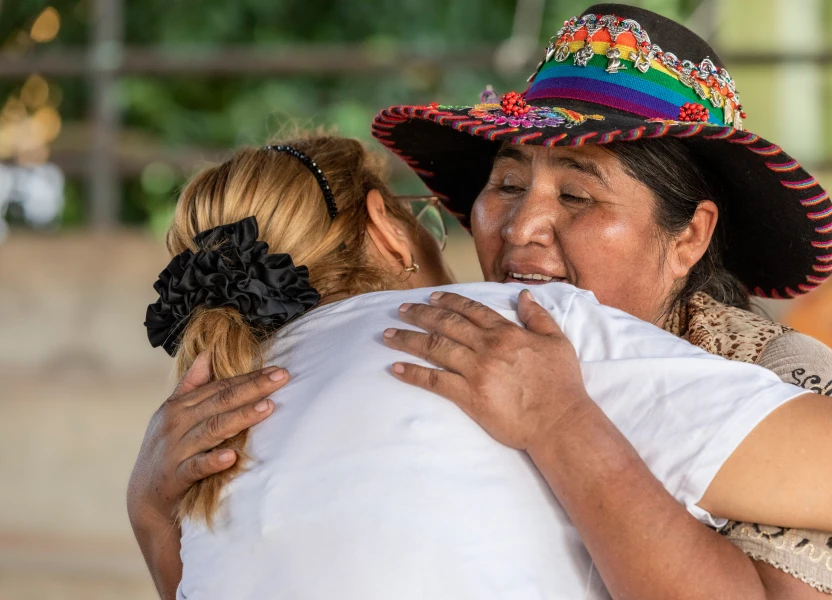
“There is a lot of sexual violence, and everything goes unpunished. I thought, why can’t we create spaces in communities where there is the greatest need and address these issues?” says Romer Orrego Ikam Executive Director of the Aguaruna and Huambisa Council in Condorcanqui
“The achievement I am most proud of is being part of this population and not being ashamed of my roots or where I come from. We will continue fighting, striving and working so that things work in the best way for us. For justice, for equity, for the right to health, for the right to life. And if it were death, a dignified death. This puts me in a position to be proud of who I am and what I am doing.”
These are the words of Fernando Chujutalli, an Indigenous man from the Lama people and regional coordinator of the Coalition of Latin American and Caribbean Indigenous Populations in the HIV Response.
Fernando is also a representative in the Horizontal Technical Cooperation Group that brings together heads of ministry of health HIV programmes and other relevant stakeholders in the region.
In Condorcanqui province in northern Peru, many Indigenous communities live in extreme poverty. Lack of access to transportation, reliance on traditional healers, sexual violence, HIV stigma, and services that do not consider these unique circumstances have led to an HIV prevalence of 1.8%, four times the national average. In an area with 57 000 mostly Indigenous inhabitants.*
Romer Orrego Ikam is one of the youngest advocates from the Awajún-Wampis Indigenous community. Now Executive Director of the Aguaruna and Huambisa Council in Condorcanqui and representative of the Indigenous population in a national multisectoral coordination body on health, Romer started hisactivism aged 20.
“I began to create and manage educational institutions [as] safe spaces for children,” says Romer. “There is a lot of sexual violence, and everything goes unpunished. I thought, why can’t we create spaces in communities where there is the greatest need and address these issues?”
Romer’s work includes convincing people that HIV is not “witchcraft”. Fernando talks about the challenges that arise when people rely on traditional healers: “We need to raise HIV awareness among traditional healers, midwives, community health agents, the shamans, the ayahuasqueros, the spiritualists. At the moment, Indigenous people receive an HIV diagnosis from state health personnel, but we do not know to what extent they understand and are understood.”
Gaps in access to services are substantial, impacted in part by high levels of internal migration and distrust of health-care workers. The community is visited by miners, drug traffickers and loggers, who are often reluctant to use condoms, contributing to the spread of HIV. Multimonth provision of antiretroviral medicines has been introduced, but lack of access to adequate nutrition means health is compromised.
Romer has seen many people in his community die from AIDS-related illnesses. On 4 March 2023, together with six other Indigenous community leaders, Romer signed a statement warning of “ethnocide”, urging the Ministry of Health and health networks to intervene.
Lourdes Huanca Atencio is President of the National Federation of Female Peasants, Artisans, Indigenous, Native and Salaried Workers of Peru (FENMUCARINAP). She says: “We do sexual and reproductive health workshops … and carry out rapid HIV testing. We provide condoms and training on how women can protect themselves.”
At least 15 members of the Indigenous communities in Condorcanqui have been trained in sexual and reproductive health. For Lourdes, this is not enough: “FENMUCARINAP wants doctors and nurses who deal with HIV to have human sensitivity and understand the brutal discrimination we, the original Indigenous peoples, face in our homeland.”
Advocacy efforts by Indigenous communities have paid off. In September 2023, the provincial authority of Condorcanqui declared HIV a public health problem. It committed to designing and implementing strategies to address HIV with an intercultural approach, and to introducing HIV as a key theme in the Roundtable for the Fight against Poverty in Condorcanqui.
Indigenous communities continue to play a role at the local, provincial and national levels, advocating for the integration of Indigenous community services and traditional knowledge into public health plans. Their involvement and leadership are fundamental to ensure communities receive the services they urgently need to stop the HIV epidemic in the Amazonas region.
* El estudio “Adherencia al tratamiento antirretroviral en personas de poblaciones Awajum y Wampis que viven con VIH/SIDA en la región Amazonas”